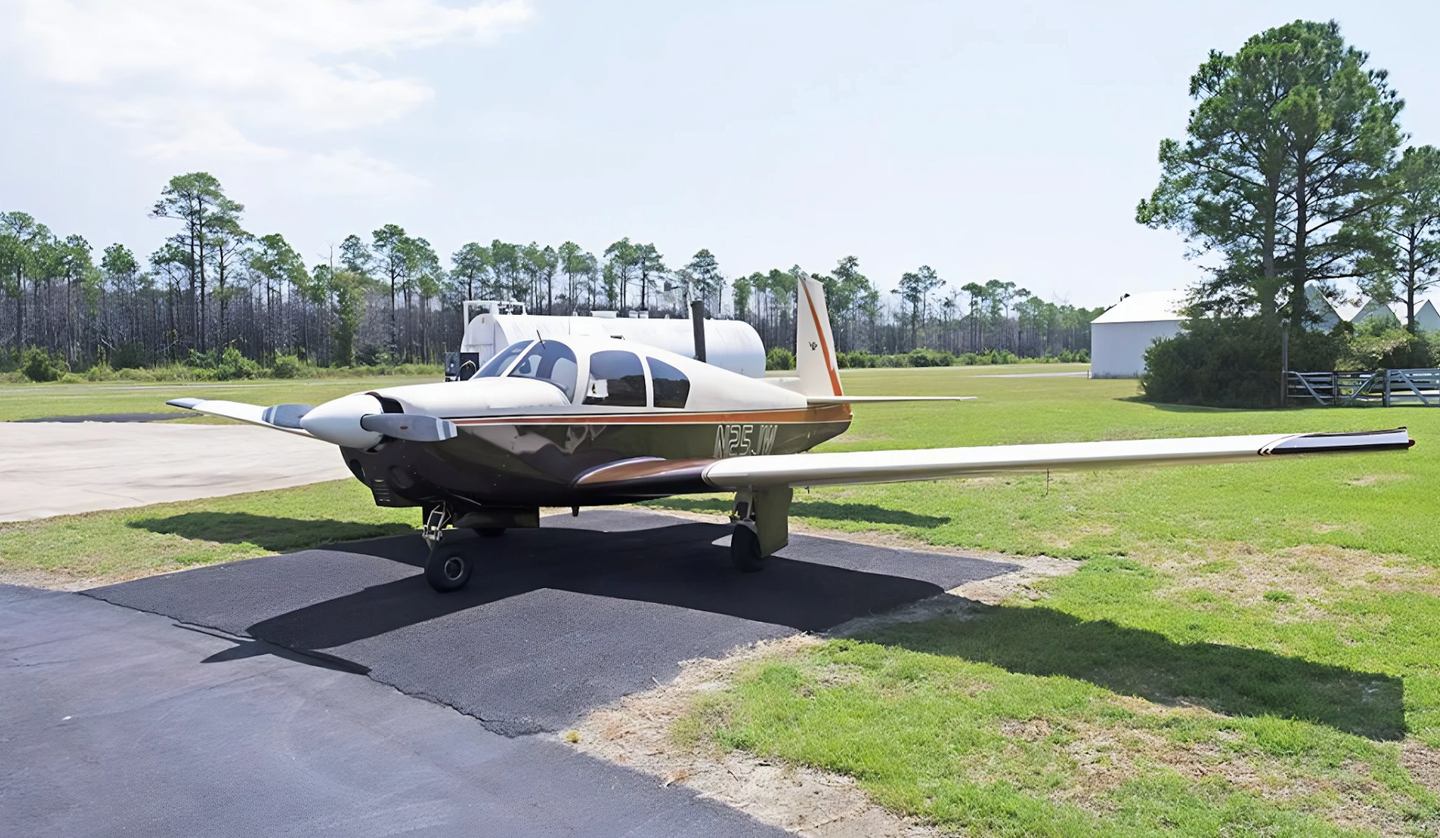Mooney Ovation 3: Turbo Performance Without The Turbo
The Ovation 3 is the fastest normally aspirated production single ever’period
 |
Say what you will about American cars, but America builds some of the best civilian airplanes in the world. In the lower rungs of general aviation, especially trainers through four-seat retractables, American flying machines have virtually no equal.
Take, for instance, the Mooney M20R Ovation 3. The current M20R is a third-generation Mooney, the beneficiary of a half century of development. Designer Al Mooney inarguably got it right the first time out of the box back in the 1950s when he created his four-seat M20. While today's airplane is light-years ahead of its ancestor in performance, comfort, systems, aerodynamics and electronics, you can still see the heritage of design---the arrogant, vertical tail; short, rubber doughnut gear; and tall baggage compartment.
Though it may not be the airplane Luke Skywalker would fly, the basic four-seat Mooney has aged at least as well as Christie Brinkley (who, more than coincidentally, is the same age) while nearly doubling climb rate and adding almost 100 knots to cruise speed.
In fact, Mooneys have consistently enjoyed speed disproportionate to their horsepower. The type has been among the world's fastest and most efficient personal airplanes since its inception. Today, the Mooney Acclaim S is the acknowledged leader in the turbocharged class, notching near-turboprop speeds on a measly 280 hp.
Similarly, the Ovation 3 is the quickest normally aspirated single---quite simply (or not so simply) the fastest production airplane above the planet without a blower under the bonnet. The Ovation 3 features essentially the same 310 hp Continental engine used on the Cessna Corvalis 350 and the Cirrus SR22-G3. (The only significant differences are associated with repositioning some items to accommodate the Mooney's retractable nosewheel.)
Mooney's Ovation 3 is actually an STC developed by Midwest M20 Mooney (www.midwestmooney.com) of Flora, Ill., but performed at the factory for the buyer who wants 310 hp rather than the standard 280 hp. The 3's Continental is rated for max continuous power at the 2,700 rpm redline, rather than the 2,500 rpm limit on the Ovation 2. The airplane can also cruise at the full 2,700 rpm, or you can pull back to 2,550 rpm, worth 262 hp or 85% power. Again, however, remember that the same engine is rated for as much as 350 hp in other applications, so the 262 hp limit represents only 75% of the max rating.
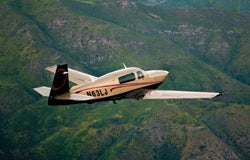 |
Combine big horsepower with a low drag coefficient (0.019) and you have the makings for a truly quick airplane. I recently did a story for this magazine titled "Looking For 200 Knots" [P&P July 2009], and it was interesting that all the true 200-knot contenders were turbocharged. There was only one normally aspirated airplane that threatened to sneak into the class, the Ovation 3, with a 197-knot top speed.
The 3's speed is an example of what can be done with excellent aerodynamics in combination with copious horsepower. The laws of aerodynamics are fairly immutable; drag increases as the square of speed. Every additional knot is exponentially more difficult to achieve, and the Ovation 3's brevity is all the more amazing in the thick air of low altitude.
Like so many other current Mooney buyers, Dr. Larry Marshall of San Diego, Calif., has owned a Mooney before. In his case, a totally tricked-out 1965 M20C, but he switched to a Turbo Skylane a few years ago to try the benefits of turbocharging. Marshall purchased his totally blissed-out Ovation 3 late last year as a replacement for the T-182.
"The Skylane was a great airplane," says Marshall, "but Rhondi and I found we rarely employed the turbocharger, and we wanted more speed in the bottom two miles of sky, where we operate most of the time."
 |
Marshall's airplane is fitted with practically every option Mooney offers except TKS, the latter rarely a requirement in the Southwest. The equipment list includes the ultimate creature comfort, air-conditioning, a 66-pound extra that reduces payload proportionately.
Okay, here come the numbers. With every option tallied, Marshall's fully equipped Ovation 3 weighs in at a hefty 2,424 pounds against a 3,368-pound gross weight. That leaves a 944-pound useful load. Subtract 100 gallons of fuel, and payload is reduced to just under 350 pounds. In Marshall's case, that works out just fine, as he and his wife weigh only about 320 pounds collectively, and baggage makes up the difference.
Creature comfort is always dependent on the size of the creatures, and the Ovation's cockpit can ensconce pilots as tall as six-foot-six. The cabin is 43.5 inches across by 44.5 inches vertical, wider than an A36 Bonanza, but not as tall. Seating position is semi-supine (laid-back), however, so modern Mooneys are hardly cramped.
The Marshall Mooney also features the Jose Monroy 130-gallon, long-range tanks, in case you're one of those strange folks who likes to endure for 10 hours at a time. The bottom line is an airplane that can fly much longer than most pilots are willing to sit, but only with two lightweights up front.
(Of course, if you can make do with the standard 100 gallons, you can still endure for 5.5 hours at about 185 knots and enjoy a range of just over 1,000 nm. That ought to be enough for anyone who's not silly enough to fly across an ocean.)
The most immediate and obvious benefit of more power comes in climb. With 310 hp on tap and only 3,368 pounds to lift, the Ovation 3 sports a low 10.9 lbs./hp power loading. All other factors being equal (which almost never happens), a low power loading generally translates to good climb performance.
Better still, climb seems relatively unaffected by load, and it seems to go on forever. Back in the 1990s, I delivered nine Ovations overseas, one from the Kerrville, Texas, factory to South Africa, and eight more from Texas to Brisbane, Australia. The Pacific trips usually departed from Santa Barbara, Calif., to Honolulu at 3,900 pounds. That's about 550 pounds over gross (with 120 gallons of additional fuel on a ferry permit). Climb was certainly affected by the overweight condition, but once the airplane caught its breath, I still saw a consistent 900 fpm climb to the typical initial 6,000- to 8,000-foot cruise height.
Marshall suggests he and his wife experience better-than-book climb numbers flying near gross. Though he rarely has occasion to fly bladder-stretching legs, the long-range tanks provide a hedge for those times when you'd rather not stop, or would prefer to hold out for a cheaper fuel price.
 Benefitting from over 50 years of development, the Ovation 3 offers an air-conditioned cabin with the Synthetic Vision--equipped Garmin G1000. |
Flying almost exactly at gross weight with Mooney's California regional sales director, Jennie Mitchell, in the right seat, owner Marshall in the aft left and Peggy Herrera in the fourth bucket, the Ovation 3 paid little attention to the load. I always climb Mooneys at a lower-deck-angle 120 to 130 knots rather than the recommended 105 knots, the better to see what I'm about to hit. At that speed, with all the knobs against the panel, the airplane logged 1,400 fpm initially, and settled on an easy 1,100 to 1,200 fpm for the short climb to 8,500 feet.
Most folks who fly little airplanes for a living (or even just for fun) acknowledge that speed is certainly one of the ultimate aphrodisiacs, and the Ovation 3 is therefore one of the sexiest machines in the sky. For our first cruise check, we went to the whip and left the engine at its full 2,700 rpm limit, just to see the top number.
Given its head, the Ovation 3 slips through the sky with the synchronicity of a Ginsu through hot butter. On our first max cruise check at 8,500 feet, I watched true airspeed settle on an eventual 192 knots, meanwhile pouring 19 gph through the engine.
At today's fuel prices, you'd need to be in a real hurry for that to make sense, so the better alternative is to climb higher into thinner air. With so much horsepower on tap, the Ovation 3 likes to fly tall where it can score reasonable economy while notching big speed. After our max performance cruise checks, we ascended to 10,500 feet, where about 70% power was all there was. Again using 2,700 rpm, we saw 189 knots for 17 gph. And, remember folks, that's flying in breathable air without a turbo. Service ceiling is a lofty 20,000 feet in case you need to buzz the summit of Mt. McKinley.
With air-conditioning keeping everyone's cool, Garmin's all-knowing, all-seeing G1000 with Synthetic Vision on duty, the talented GFC 700 autopilot to help drive and the big Continental chortling happily, the Ovation 3 makes an excellent ride in the middle sky. The Bose X headsets make the noise level moot, and all four occupants enjoy armrests and plenty of head and elbow room in a bright, comfortable cabin. It's not a G550, but it's also about $52 million less expensive.
If I owned an Ovation, I'd probably fly it most of the time at 10,000 feet or higher. Traffic is less of a hassle up high, weather tops are usually well below, speed and efficiency are better, and the safety margin improves with every 1,000 feet. At two miles AGL, you can glide roughly 20 miles in any direction.
When it comes time to return to earth under power, the Ovation 3's standard speed brakes allow it to decelerate like the Enterprise coming out of warp drive. On such a truly slick airplane, the Precise Flight speed brakes provide an excellent hedge against shock cooling, allowing a pilot to execute those frustrating go-down/slow-down directions from ATC without TBO-shortening power reductions.
Landings are far simpler than the airplane's reputation might suggest. Dirty stall checks in at 59 knots, so a reasonable approach speed is anything over 75 knots. Mooneys have long been accused of being floaters, but if you keep the approach speed to 80 knots or less, that's rarely a problem.
We don't normally talk much about flight manuals, but the Ovation's is one of the best I've seen---well executed, comprehensive and full of more information than you'll probably ever use. That's a welcome change from the days when flight manuals often seemed written by a dozen monkeys on IBM Selectrics. In researching this article, there were hardly any questions left unanswered by the Ovation 3's POH and supplement.
Like many other general aviation manufacturers, Mooney Airplane Company is currently in a state of suspended animation, waiting for a turnaround in the economy. After years of rosy predictions of increasing sales, the aircraft companies have discovered the future isn't what it used to be, but then, it probably never was. Mooney sold 65 airplanes in calendar year 2008, probably $30 million worth---not so bad. We can only hope 2009 will be better.
By any measure, Mooney has always been a survivor. The company that helped define performance and efficiency a half century ago continues to lead the industry in the parameter that excites pilots most---speed.
| Tips For Using The Garmin G1000 | |||
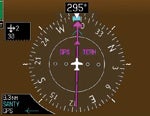 1 Know both the Crosswind and HeadWind Components. Both ATIS and AWOS/ASOS provide information on airport winds, but the information often is either old (ATIS) or not applicable to the approach or to the runway itself. For a good reference on the changing wind speed and direction during the approach, set the G1000's PFD display to show both crosswind and headwind components. It also provides a good last-glance crosswind reference as you prepare to land. 1 Know both the Crosswind and HeadWind Components. Both ATIS and AWOS/ASOS provide information on airport winds, but the information often is either old (ATIS) or not applicable to the approach or to the runway itself. For a good reference on the changing wind speed and direction during the approach, set the G1000's PFD display to show both crosswind and headwind components. It also provides a good last-glance crosswind reference as you prepare to land.
Choose one of three wind display options by pressing the PFD's soft key, followed by the Wind soft key, and then selecting the desired wind display. OPTN 1 and 3 provide both headwind and crosswind components so you can choose your favorite display. |
|||

Subscribe to Our Newsletter
Get the latest Plane & Pilot Magazine stories delivered directly to your inbox

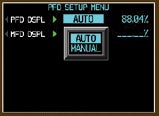 2 Dim the Screens at Night. As beautiful as the PFD and MFD screens are, even with their automatic dimming, they can be too bright at night. You can dim the MFD by turning off the topography display at night, but the PFD will remain bright. Better yet, the PFD has an option that allows you to individually adjust the brightness of either display. To change the backlighting, with the Flight Plan window closed, press the PFD's MENU button to open the PFD Setup Menu window, select MANUAL and choose the brightness that works best.
2 Dim the Screens at Night. As beautiful as the PFD and MFD screens are, even with their automatic dimming, they can be too bright at night. You can dim the MFD by turning off the topography display at night, but the PFD will remain bright. Better yet, the PFD has an option that allows you to individually adjust the brightness of either display. To change the backlighting, with the Flight Plan window closed, press the PFD's MENU button to open the PFD Setup Menu window, select MANUAL and choose the brightness that works best.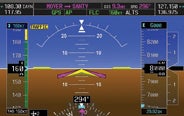 3 Manage your Speed in Turbulence. It can be a handful to fly in turbulence while managing everything else. The smart pilot uses the autopilot. The G1000's GFC 700 offers both rate of climb (VS) as well as constant-speed (FLC) climbs and descents. When in turbulence, consider using the FLC option for a constant-airspeed climb or, especially, descent. Just set it for the appropriate maneuvering speed using the NOSE UP and DN buttons and use the throttle to adjust the fpm rate. If the turbulence is really bad, turn the autopilot off and hand-fly, keeping the aircraft's pitch and roll level. Remember that the POH's maneuvering speed value is for the aircraft's maximum certified weight. Decrease airspeed for lower gross weights.
3 Manage your Speed in Turbulence. It can be a handful to fly in turbulence while managing everything else. The smart pilot uses the autopilot. The G1000's GFC 700 offers both rate of climb (VS) as well as constant-speed (FLC) climbs and descents. When in turbulence, consider using the FLC option for a constant-airspeed climb or, especially, descent. Just set it for the appropriate maneuvering speed using the NOSE UP and DN buttons and use the throttle to adjust the fpm rate. If the turbulence is really bad, turn the autopilot off and hand-fly, keeping the aircraft's pitch and roll level. Remember that the POH's maneuvering speed value is for the aircraft's maximum certified weight. Decrease airspeed for lower gross weights.
